Russian Navy. Sad look into the future. Part of 4. "Halibut" and "Lada"
Before proceeding with the analysis, let us try to answer the question: why do diesel submarines (diesel-electric submarines) need in the age of atomic energy? Do they have their own tactical niche, or diesel-electric submarines - is it "weapon for the poor ”, ersatz boats for those who do not have the ability to create atomarins?
In order to understand all this, we recall two very interesting episodes of the “life” of DEPL. The first of these is the Falkland Conflict of 1982. As you know, on the part of Argentina, one and only San Luis submarine took part in naval battles. Strictly speaking, the Argentines also used the Santa Fe, but the boat was in such a terrible technical condition that it could barely go under the periscope, so that its quick death was obviously predetermined and in no way connected with the type of its power plant. “San Luis”, built according to the German project “Type 209”, is a completely different matter. In 1982, it was one of the best (if not the best) DEPLs in the world, but it faced a very difficult task. The boat was to fight almost alone against a whole squadron of British ships. Of course, the Argentinean tried to do something aviationbut for a number of reasons she couldn’t coordinate her actions with the San Luis, and the commandos did not send surface ships to the battle. Opponent of “San Luis” many times exceeded the Argentine diesel-electric submarine in numbers, and besides, the English sailors and officers of those years were distinguished by the highest professionalism. But, as if all this was not enough, we should not forget that in the framework of the distribution of functional responsibilities between the NATO Navy, the fleet of the former "mistress of the seas" was focused on anti-submarine activities. The KVMF was to fight against Soviet submarines breaking into the Atlantic and protect communications from those who succeed.
So, on the one hand, two small aircraft carriers, carrying, among other things, anti-submarine helicopters, nine ships of the destroyer-frigate class (at the beginning of the conflict, then there was more), and on the other, one and only submarine. And what is the result? "San Luis" at least twice, and, perhaps, three times attacked the British ships. The most colorful was the episode of 1 on May, when this boat attacked the destroyer “Coventry”, which was accompanied by the frigate “Arrow”. The torpedo was defective, its control was lost, and the homing head “captured” the torpedo trap, which the frigate towed and struck it.
After that, two British frigates and three helicopters chased the San Luis for 20 hours, while the frigates maintained sonar contact with it, and the helicopters attacked with torpedoes and depth charges. Despite all this, the "San Luis" managed to survive and get out of attack.
Second case (May 8) - The submarine San Luis attacked an unknown target with a torpedo. The acoustics of the “San Luis” seemed to have even heard the sound of a hit, but the torpedo did not work. Perhaps it was all a mistake, and there was actually no enemy near San Luis, but there is some reason to believe that the Argentines managed to get to the atomizer Splendite (there is evidence that after this incident Splendite left the combat area and went to the UK, and there were no other ships and vessels in the San Luis attack area). However, the British did not confirm this.
And finally, the third case took place on the night of 10 on 11 in May, when San Luis attacked the frigates Alakriti and Aerrow from the distance of the entire 3 mile with a two-torpedo salvo. The torpedoes, as usual, refused, the British did not find the boat.
The second episode - Joint Task Force Exercise 06-2, held in December 2005. At which non-nuclear Swedish submarine "Gotland" first "destroyed" the US Navy nuclear submarine covering the AUG led by the aircraft carrier "Ronald Reagan", and then attacked surface ships and "sank" the aircraft carrier.
And this is not an ordinary case in the exercises of the Naval Forces of the West. In 2003, the same "Gotland" was able to prevail over American and French atomarins. The Australian “Collins” type boat and the Israeli “Dauphin” type managed to break through the USG AUG anti-submarine defense.
How did non-nuclear boats do that?
To begin with, let's pay attention to the key condition of victory in underwater combat. Obviously (at least in the exercises), the one who can find the enemy first, will come out on top, while remaining undetected. In combat conditions this may not be the end and some options for the attacked submarine are possible: it may turn out to be out of the blow.
What determines the fulfillment of the key condition? The power of the hydroacoustic complex of the boat and its low noise level must be balanced so as to allow the enemy to be detected before the enemy can do it.
All of the above is fairly obvious and probably does not require confirmation, but what is written below is the guesswork of the author, who, as already mentioned, is neither a shipbuilding engineer, nor an officer, a submariner, and works exclusively with data from the open press.
Presumably, the atomic propulsion, with all its advantages, has one serious drawback: it creates more noise than a non-nuclear boat going under electric motors. A significant role in these noises is played by the circulation pumps moving the energy carrier and other units characteristic of NPS, while it is impossible to completely turn off the reactors during a combat campaign. Accordingly, it can be assumed that of the two submarines, nuclear submarines and diesel-electric submarines, built on an equal level of technology and design thought, the diesel submarine will have less noise. This is indirectly confirmed by information about the noise of our third-generation boats, the 971 Pike-B atomic project and the 877 Paltus diesel project. With the natural noise level in 40-45 decibels, in calm the noise level of the “Pike-B” is estimated 60-70 decibels, and “Halibus” - 52-56 decibels. Here, again, it is worth mentioning that it is completely unknown who and when carried out measurements of these noises ...
At the same time, as far as can be understood from open sources, the dependence of noise and detection range is by no means linear. It means that if, say, a boat reduced noise by 5%, then its detection range is reduced not by 5%, but significantly more significantly.
As for the hydroacoustic complexes, the diesel submarine itself is not large, and it is unlikely that it can be equipped with a SAC as powerful as on atomarine (although a similar attempt was made in the USSR, but more on that below)
So, if the above assumptions are true, the success of foreign non-nuclear submarines (and our nickname "Black Hole") appeared as a result of this combination of its own noise and power SAC, which allow the diesel-electric submarines to be the first to detect submarines. And as long as such a combination remains possible, the diesel-electric submarines will remain ships, with their tactical niche, and not a “weapon for the poor.”
What can and what can not diesel submarines? By virtue of their low noise, they are almost an ideal means of dealing with an overwhelming adversary whose location is known in advance and does not change. For example, the Royal Navy in the Falklands was in this position - the carrier group was forced to maneuver in approximately the same area. And the analysis of San Luis actions shows that if the Argentines had not one but five or six boats of this type with trained crews and combat-ready torpedoes, then the British compound could well have suffered such heavy losses during their attacks that impossible.
Judging by the available data, the successful use of Australian, Swedish and Israeli non-nuclear submarines against AUG was achieved under conditions when the aircraft carrier was “tied” to a certain square and its location on the submarine was known. That is, non-nuclear submarines no one created problems with access to the enemy’s maneuvering area, and it was only a matter of checking whether the full-time defense of the AUG could withstand an attack of non-nuclear “quiet”.
Consequently, diesel-electric submarines represent a formidable danger and a strong deterrent for all who wish to operate large forces in close proximity to our shores for a long time. However, due to its design features, diesel-electric submarines have significant limitations on the speed and range of the underwater course. So, the 877 “Halibus” submarine is capable of overcoming 400 miles under water at a speed of only 3 knots: it can move faster, but only at the cost of a sharp drop in range. That is why diesel-electric submarines can be effectively used only against such an enemy, whose location is known in advance and does not change for a long time. And this imposes significant restrictions on the combat use of diesel-electric submarines.
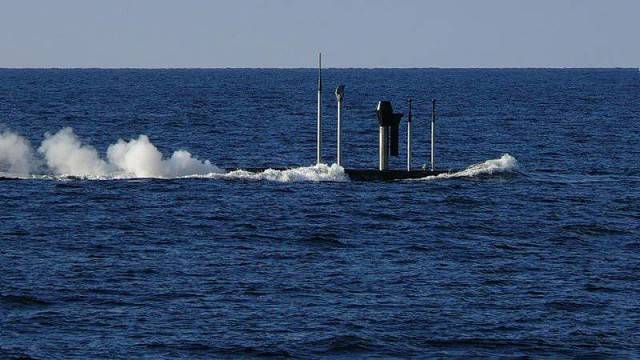
So, for example, the role of diesel-electric submarines in the issues of anti-submarine warfare drops sharply. Of course, the diesel-electric submarine in a duel situation can destroy a nuclear submarine, but the problem is that such a situation is possible only if the diesel-electric submarine attacks a ship order that covers the nuclear submarine from under the water, or ... in general, by chance. Of course, no one bothers to unfurl the curtain of diesel-electric submarines on the paths of likely submarine submarines, but due to the relatively weak HOOK and low underwater speed, the capabilities of these boats to search are rather limited. In addition, the short range of underwater travel in combination with low speed does not allow the diesel-electric submarine to quickly move into the area where the enemy submarine was found. Or, for example, accompany the SSBN on the route of its nomination.
Thus, the diesel-electric submarine, being certainly an important and useful weapon system of the Russian Navy, still cannot solve the whole range of tasks of an underwater war.
What does our navy have today? The most numerous are already mentioned in the article of the diesel-electric submarine of the 877 “Halibus” project. To date, 15 boats of this type are listed, including five different subtypes.
The “initial” type diesel-electric submarines of the 877 type remained in the ranks of four units: B-227 “Vyborg”; B-445 "St. Nicholas the Wonderworker"; B-394 "Nurlat"; B-808 "Yaroslavl". In NATO, the boats received the designation "KILO".
The diesel-electric substations of type 877LPMB B-800 “Kaluga”, on which some novelties used in the following subseries were tested. So, for the first time in Kaluga, not a classic six-blade, but a seven-blade saber screw was used on boats of this type.
Boats type 877М, eight units: B-464 "Ust-Kamchatsk"; B-459 Vladikavkaz; B-471 Magnitogorsk; B-494 "Ust-Bolsheretsk"; B-177 "Lipetsk"; B-187 "Komsomolsk-on-Amur"; B-190 Krasnokamensk; B-345 "Mogocha". The ships received a new propeller, a modernized GAK (instead of the analogue MGC-400 "Rubicon", the MIC-400M "Rubicon-M" created on the basis of the computer) was installed, improved BIOS and control of the ship systems. 877M boats have been labeled “Improved KILO” at NATO
The project 877ECM (abbreviation means "export commercial upgraded"), in principle, is similar to 877M, but is intended for operations in tropical seas. The Russian Navy has one submarine of this subtype: the B-806 "Dmitrov". The ship was built for Libya, but in the USSR it was decided to leave one boat of the 877EKM project for themselves in order to train the crews of export boats on it.
And, finally, the 877В project - the B-871 “Alrosa”, is a boat of the 877М type, but with the replacement of a screw propulsion unit with a jet one. "Alrosa" is considered the quietest boat among all "Halibut".
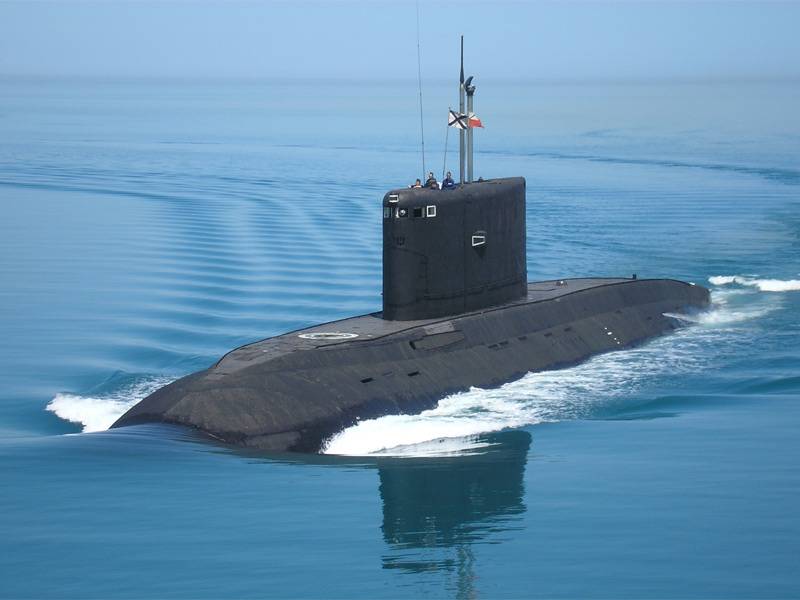
Most of the boats are in the active forces: only 15 are undergoing repairs from 3 ships, and perhaps only two, since it is unclear whether Dmitrov got out of repair B-806, they were going to finish it in 2017.
877 type boats have become an excellent weapon for their time. In the years of their design, an attempt was made to create a single hydroacoustic complex for nuclear and diesel submarines (SAC MGK-400 "Rubicon"). The SJC was very large, but for the promising submarines it didn’t “go,” but it turned out to be much more powerful than everything the domestic diesel-electric submarines had. As a result, according to some data, the 877 project was built “around the SAC”, which predetermined the rather large size of the “Halibus”. However, their ability to detect an underwater enemy turned out to be very high, which, combined with their low noise level, gave them the key ability of a successful diesel-electric submarine: "to see the enemy remaining invisible." In the book "Whale's Jump," there is evidence of an eyewitness - a representative of the service team S. V. Kolon:
Of course, the boats were not without flaws. The author has repeatedly come across remarks that the rather large size of the “Halibus” hampered their use in the Baltic and Black Seas. On the one hand, this is strange, but on the other hand, attention should be paid to the fact that the majority of XDUMX diesel-electric submarines in the Northern and Pacific fleets were serving. The SJC was powerful, but did not have on-board antennas, there was also no towed antenna, which is very important for the diesel-electric submarines, as when charging the batteries, the full-length SJC loses much of its capabilities due to interference, and the towed antenna is subject to them to a much lesser degree.
Certain flaws did not prevent the "Halibut" to be a formidable weapon at the end of the 20 of the 20th century. But in terms of their technological level, they correspond to the generation NPS of the 3, and today they are outdated. No matter how powerful their Rubicon is, it is, in its capabilities, inferior to Sjuk-B and Los Angeles. For the Rubikon State Joint-Stock Company MGK-400, the detection range of the submarines 16-20 km is indicated, and the surface ships 60-80 km. (again, in what conditions and at what noise is the submarine?) At the same time, it is reported that the Pike-B received the Skat-540 SAC not inferior to the American AN / BQQ-3 and AN / S / S BQQ-5, for which the detection range of the submarine is indicated (apparently in certain ideal conditions) to 6 km. On the other hand, open sources indicate that AN / BQQ-160 is able to see the “Pike-B” not further, as in 5 km, according to other data, it is not detected by them at low noise, but then the same applies to "Halibus."
It can be assumed that “Halibut”, having a weaker GAK but, probably, a lower noise level than “Improved Los Angeles” will be approximately equal to it in a duel situation. But "Halibut" will not be able to withstand on an equal footing "Virginia", since it is much quieter than the "Improved Elk" and has a more powerful HOOK. In the duel of "Halibut" and "Virginia" "to see the enemy remaining invisible" will be the American atomarina.
In addition, "Halibut" entered into operation in the period 1983-1994, and today it is from 23 to 34 years. It is not surprising that submarines of this type are currently being withdrawn from the Russian Navy, despite the general shortage of submarines in the Russian Navy. In the period of 2016-2017 g fleet left B-260 "Chita"; B-401 "Novosibirsk"; B-402 "Vologda" and, obviously, this process will continue further. In general, it should be expected that in the next decade all boats of this type will leave the system.
They should have been replaced by non-nuclear submarines of the 4 generation of the Lada 677 project.
The development of these ships began in 1987, and the designers had an extremely difficult task, because they had to create a ship that was superior to the previous generation of diesel-electric submarines in everything. Interestingly, the main differences of the new diesel-electric submarines from the boats of the previous generation strongly resemble those of the MAPL project 885 "Ash".
Of course, great attention was paid to reducing the noise of the 677 project. Here is the departure from the two-body design in favor of a single-body (although it is still more likely a half-body), and a new all-mode electric motor, special shock absorbers, designed to dampen the noises of vibroactive equipment, a new body covering. Of course, the new Lyra hydroacoustic complex, the new CBS, communication systems and so on, as well as the ability to use cruise missiles: the 877 and 877 project boats did not have such an opportunity. There were many other new products - just about the Lada-type boats, about 180 development work was carried out. There is no doubt that in case of successful implementation of the planned indicators, the fleet would receive a non-nuclear submarine capable of successfully fighting atomic 4 generation.
Alas, the desire to create a truly new non-nuclear submarine played a cruel joke with the 677 project. Even in the USSR, such a high concentration of new products threatened to seriously tighten the finishing of boats of this type, and even after the USSR was destroyed in 1991, the work on the “Lada” complicated to the extreme. A reduction in funding, coupled with an artificial "acceleration" of development work periods and a break in cooperative chains, and the general situation of the universal mess also had an effect. But it was about the design and fine-tuning of the set of components and assemblies of a new, not previously used design.
The first boat of the 1997 project “Saint Petersburg” was laid in 677, and after it, the construction of the same type of Kronstadt and Sevastopol began in 2005 and 2006. Alas, the creation of such a complex system of naval weapons as a new generation of diesel-electric submarines turned out to be too tough for Russia of the 90s. “St. Petersburg” was expectedly turned into a long-term construction project - the boat was launched into the 2004 g, but only in 2010 could the fleet be handed over to the fleet - and then only in trial operation. The newest equipment refused to work, did not show the required power, etc. The construction of the remaining two boats of this type was suspended in 2009 g, and only in 2013-2015 was it resumed under an improved project, while the Sevastopol laid down in 2006 g was rebuilt in 2015 g, i.e. later 9 (!!!) years after the start of construction with the name "Great Luke".
As a result, the Russian Navy found itself in an extremely unpleasant situation. The existing diesel-electric submarines have already served their due dates and, alas, no longer fully complied with the requirements of the war at sea, and there is nothing to replace them. As a result, a half-hearted, but absolutely right decision was made - to build the diesel-electric submarines of the 636.3 Varshavyanka project in large quantities.
The 636 project appeared as an improved export version of the 877ECM boat, and, in fact, is a well-modernized “Halibut”. In the 636.3 variant, the DEPL received a number of technologies developed in the process of creating the Lada, which allowed Varshavyanka to become a much more formidable weapon than the boats of the 877 / 877М project. But it should be understood that no upgrades and new technologies can put these boats on a par with 4-generation submarines. It may be worth mentioning the Varshavyanka as the “three and a half” or “3 +” generation ships, but they cannot fight on equal terms with the Sivulfs and the Virginia. Serial construction of the 636.3 project was carried out not because the boat fully complied with the requirements of the Russian Navy, but because the refusal of such construction was fraught with the fact that the Russian fleet would have been left without non-nuclear submarines. That against the background of a total reduction of the nuclear submarine fleet would have turned into a real catastrophe.
So, the fleet badly needs non-nuclear submarines of the 4 generation, and what is the situation today? At some point, it was decided that the 677 project did not at all justify the hopes placed on it and seriously considered the issue of stopping work on the Lada and developing an entirely new ship, Kalina. Works on its design were very intensive. But it was clear that the problems faced by the designers would somehow “crawl out” on the next type of boat, therefore “St. Petersburg” continued to be operated in the hope of bringing the equipment to the required conditions. 7 years have passed, but to this day, one cannot say that the “stuffing” of “St. Petersburg” works satisfactorily. If this were different, no one would have started laying new diesel-electric submarines for the Pacific Fleet at the end of July 2017 on the outdated 636.3 project.
But it seems that the “light at the end of the tunnel” still appeared, and there is reason to expect that “Kronstadt” and “Great Luke” will still reach the required parameters. First of all, this is evidenced by the fact that the deputy commander-in-chief of the Navy, V. Bursuk, announced the desire of the fleet to order the following two boats of the 677 type. It is unlikely that this will happen before the second boat of the 677 project confirms the characteristics expected from it, and in any case it is about building only two Ladas to 2025. The manufacturer says that from the moment of the decision to the delivery the fleet must pass 5 years. Taking into account the fact that Kronstadt is going to be launched in 2018 g, and transferred to the fleet in 2020 g, we can expect the entry of new boats into operation by 2025.
In general, according to domestic diesel-electric submarines, the following can be stated. At the beginning of the GPN 2011-2025, the fleet included the 18 diesel-electric submarine of the 877 "Halibut" project. It should be expected that by 2025 g they all leave the line. They will be replaced by 12 diesel-electric submarines of the 636.3 project, which, unfortunately, do not fully meet the requirements of the modern naval war and four boats of the 677 project (most likely, that St. Petersburg will remain an experienced ship and will not reach full combat capability) Thus, our non-nuclear fleet expects a small, but still declining number.
In addition, diesel-electric submarines will be redistributed to theaters. If currently from the 18 diesel-electric submarines of the 877 project on the Black and Baltic seas there were only 3 submarines (one on the Black Sea Fleet and two on the Baltic), then six of the 16 new diesel-electric submarines will serve on the Black Sea. Taking into account the need to have at least one diesel-electric submarines in the Baltic Sea (most likely there will be two) to the Northern and Pacific Fleets, in the aggregate, only 8-9 ships remain instead of 15-ti.
On the one hand, taking into account the international situation, we cannot afford to keep the Black Sea Fleet without submarine forces — we need them in the Mediterranean. But on the other hand, it turns out "trishkin caftan", when at the cost of military presence in the Mediterranean we strongly expose the North and the Far East.
The conclusion is sad - against the background of a completely inadequate number of multi-purpose submarines to cover the deployment areas of SSBNs, in the next decade, we will significantly reduce the number of submarines that can assist MAPL in carrying out this key task for the fleet. But, in addition to reducing the number of diesel-electric submarines, which we can use to cover the SSBN, we are losing as such a cover. Instead of 15 boats, we will have only 8-9 (of which six 636.3 will be included in the Pacific Fleet, and 2-3 677 submarines of the SFN project - in the SF. But if the "Halibuses" could oppose the "Los Angeles" on an equal basis, the boats of the type 636.3 is unlikely to stand up against Virginia. And the 4 generation's diesel-electric submarines will only have 2-3 things.
Thus, the existing plans for the creation of non-nuclear submarines do not at all cover the shortage of multipurpose atomarines. And due to the massive equipment of the US Navy 4-generation submarines, in addition to the quantitative gap, as a result of the disruption of the construction of the submarines of the 677 project, we also get a qualitative loss.
A small postscript.
There is one more aspect in the construction of non-nuclear submarines - apparently, until 2025 r, not a single boat with VNEU will be part of the Russian Navy. However, it should be borne in mind that in terms of air-independent power plants, there are more questions than answers for the time being.
Currently, a number of fleets are already operating the submarine with a VNEU, but information from the open press does not allow us to assess the success of the application of VNEU on submarines. To date, there are two main schemes VNEU used on the submarine:
1. Power plants with electrochemical generators.
2. Engines with external heat supply (Stirling engines).
The first type of VNEU is implemented on German submarines of the 212 type. At the same time, in open sources there are enough rumors on the topic that boats of this type turned out to be very capricious and rather noisy. On the other hand, it can be assumed that the source of these rumors were the numerous complaints of the Greek Navy about the boats delivered to them by Germany.
But it is more than likely that Greece in this case simply tried to make a “good happy bad game.” It is very likely that the Greeks, not having the means to timely pay for the German submarines, preferred to criticize the ships delivered to them in tatters, but not to confess their own insolvency.
On the other hand, of the six boats of this type in the composition of the German Navy, not one is on the move. This is an alarming signal, but what is to blame for the shortcomings and excessive capriciousness of the VNEU, or the paucity of the military budget of Germany, which has already become the talk of the town?
As for Stirling engines, there are also a lot of questions about them. Of course, there is an objective success of the Swedish submarine "Gotland" in training battles against the American and French fleets. But who was the opponent of "Gotland"? The French submarine, but with all its undoubted advantages, is the 3 generation ship. The battered American Atomarina is SSN-713 "Houston", that is, the usual "Los Angeles", not even "Improved". Would “Gotland” show the same result in a fight with “Sivulf” or “Virginia”? Question…
An interesting aspect. Our advantage in low noise, our diesel-electric submarine "Halibut" was only when using the auxiliary propulsion (thruster water cannons), which have all the boats of this type. But when driving under the main motor noise increased significantly over the entire speed range. I wonder how things are with the noise at the "Gotland" when operating Stirling engines? Could it be that Gotland attacked and succeeded using only batteries with the engines off? If so, then the utility of Stirling engines is far from as high as it seems at first glance.
In this light, the actions of the Japanese Navy are extremely interesting. Having built a large series of non-nuclear Soryu submarines with VNEU and having extensive experience in their operation, the Japanese Navy abandoned the Stirling engine in favor of lithium-ion batteries.
This type of battery is much superior to conventional diesel-electric submarines in capacity and mass-dimensional characteristics, so that at low speed, submarines with lithium-ion batteries are not too inferior in range of submarines with a VNEU. At the same time, lithium-ion batteries require significantly less time for recharging - accordingly, in the presence of a diesel engine, the diesel-electric submarines are able to “recharge” much faster, reducing the time of increased noise to a minimum. But lithium-ion batteries are an expensive pleasure. In the open press, it is stated that non-nuclear submarines with VNEU are more expensive than conventional diesel-electric submarines, but boats with lithium-ion batteries are more expensive than VNEU. So, the bmpd blog claims that:
And if the Japanese Navy, having experience in operating Stirling engines, is still switching to more expensive lithium-ion batteries - does this mean that lithium-ion batteries turned out to be a better choice than Stirling engines? It remains to recall the words of the former commander of the submarine forces of the Japanese fleet, Retired Vice Admiral Masao Kobayashi. In his opinion, the use of lithium-ion batteries:
So, in the Russian Federation today and which year work on the VNEU is underway. But, despite the constant announcements of “things and now there” - not a single operating VNEU has yet been demonstrated. But, on the other hand, in terms of lithium-ion batteries, we have advanced far enough, Rubin Central Design Bureau informed 2014 g in December of the completion of their tests, and according to some information, two new submarines of the 677 project are supposed to be built with lithium-ion batteries batteries. Interestingly, if for “Paltus” the range of the underwater stroke was indicated in 400 miles on 3 nodes, and for the 677 project it was already 650 miles, then the use of lithium-ion batteries will increase this figure at least 1,4 times (the words of the former general director “ Rubin "A. Dyachkova) up to 910 miles, which is 2,27 times more than the “Halibus”. At the same time, A.Dyachkov in 2014 g said that for the time being we use the potential capabilities of these batteries only on 35-40%, i.e. it is possible that the new “Lada” will have even more impressive opportunities for underwater travel.
By virtue of the above, the fact that work on the VNEU is clearly not set in the Russian Federation does not threaten our non-nuclear submarines with some kind of catastrophe and doom to be dragged along by the rest of the world's fleets. Much more important for the domestic submarine fleet are not at all the number of “Caliber” and not VNEU, but such things as:
1. Effective anti-submarine torpedo armament.
2. Pitfalls-imitators, forcing enemy detection and destruction "to be distracted" to a false target. Such units were in service with the diesel-electric submarines of the 877 type, but they could only be taken in exchange for part of the munition and had very limited capabilities.
3. Active anti-torpedo systems. To date, small-sized torpedoes "Package-NK" are at least one of the best means of dealing with attacking torpedoes, but there is no information about installing them on the submarine.
4. Means of electronic warfare that can interfere with a sonar buoy and its carrier - an airplane or a helicopter.
5. SAMs that can effectively counteract the enemy antisubmarine aviation.
Are there any work in these areas today? For today it is known only about the progress in the part of torpedo weapons: new torpedoes “Physicist” and “Case” were adopted. The author does not have the data to compare these torpedoes with the latest imported models, but, in any case, they will expand the capabilities of our submarines. As for everything else, the author in the open press did not meet any information on R & D on the issues voiced above. That, however, does not mean that such work is not being conducted.
To be continued ...
Previous articles of the cycle:
Russian Navy. Sad look into the future
Russian Navy. A sad look to the future (part of 2)
Russian Navy. Sad look into the future. Part of 3. "Ash" and "Husky"
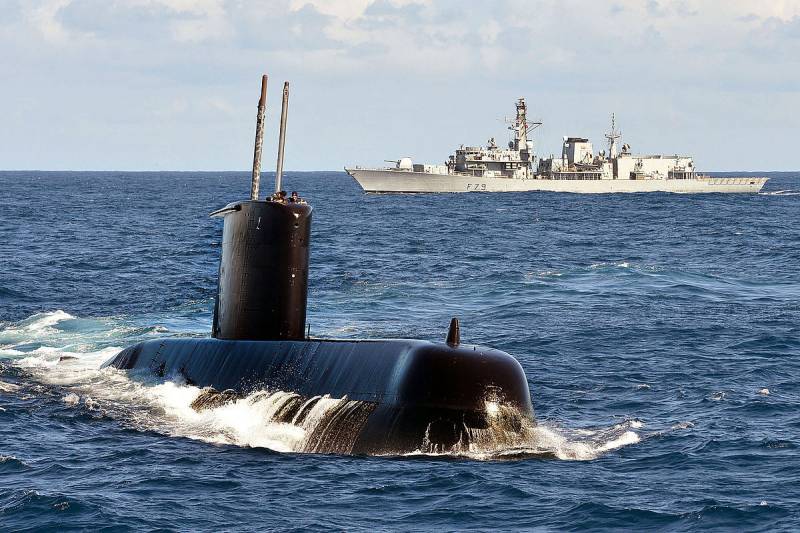
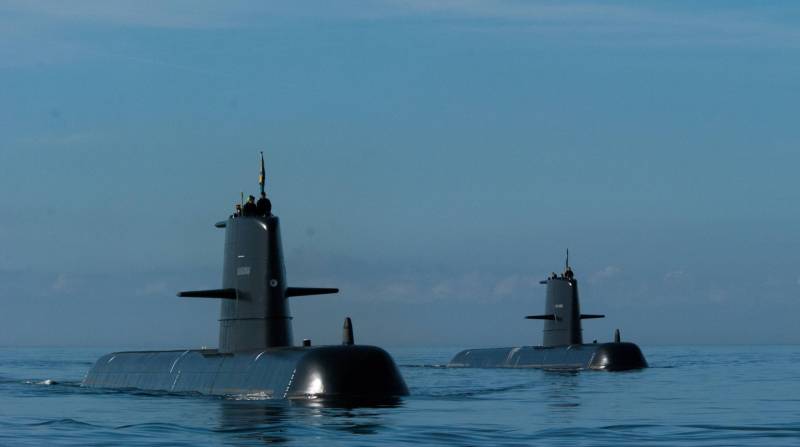
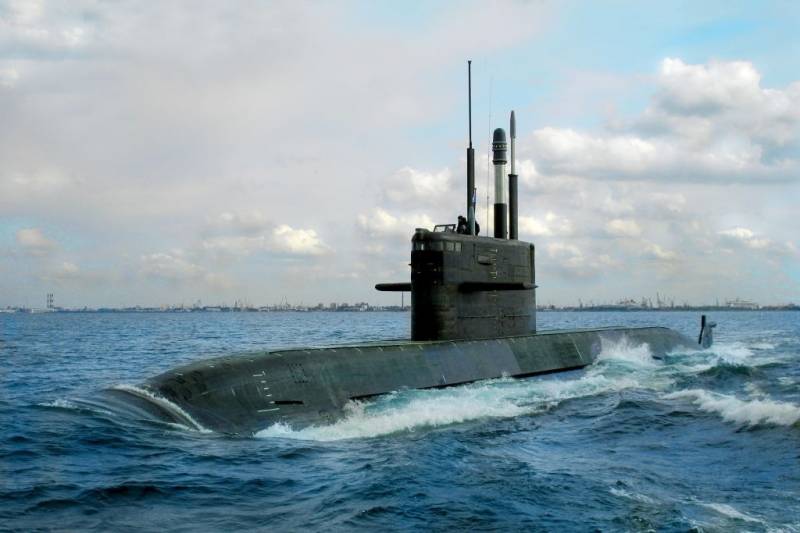
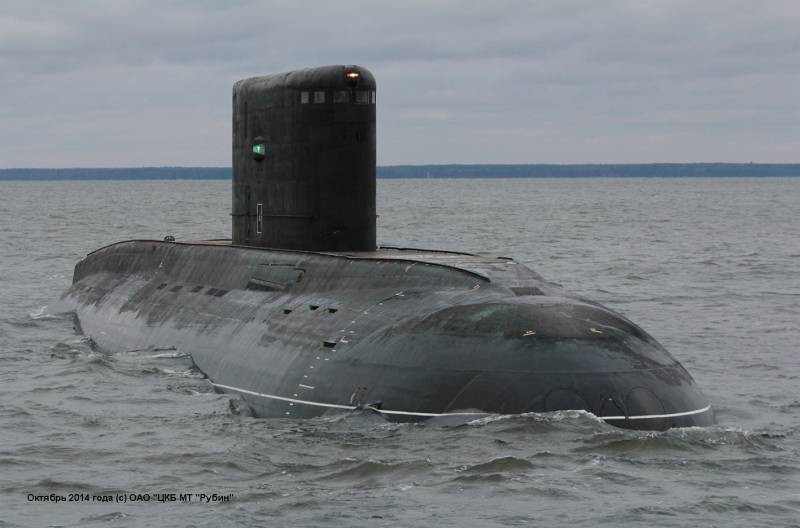
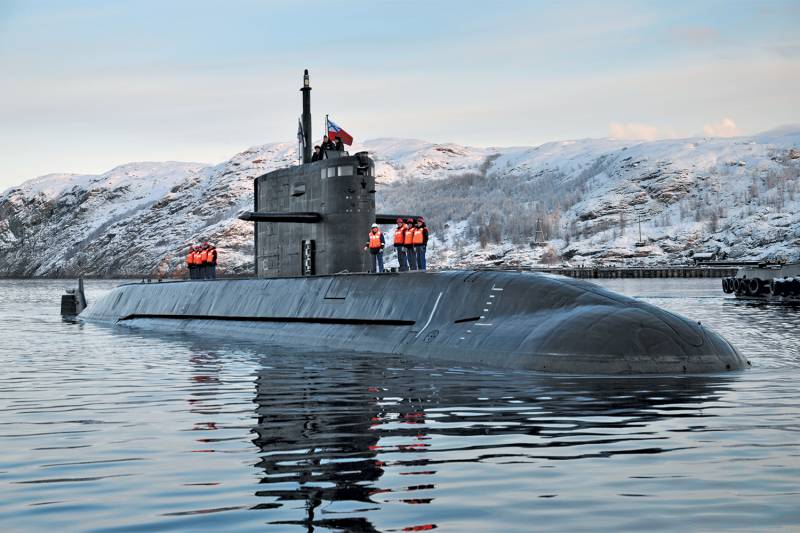
Information